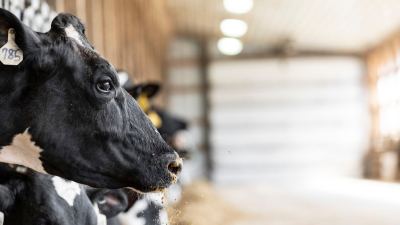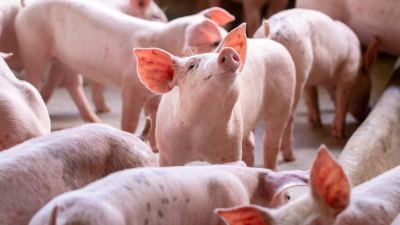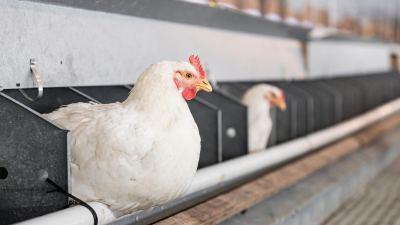Tips for choosing the right TMR mixer

The following article is adapted from a chapter of the book TMR: Premium Dairy Cows by Prof. Dr. Viroj Pattarajinda, Animal Science, Faculty of Agriculture, Khon Kaen University
Making an effective TMR requires an investment in the right mixing machines. There are many types from different companies, offering varying prices and quality.
The quality of the materials is important. For instance, since a TMR contains acidic, fermented raw materials, the mixer should have high-quality steel. And especially if straw is your TMR ingredient, the machine’s blades must be durable.
Types and characteristics of TMR mixers
The most commonly used types of TMR machines are horizontal mixers and vertical mixers.
Horizontal mixer

This type usually has 2–4 spiral augers, depending on capacity. The machine works by the bottom spiral auger spinning to mix feed materials and cutting them with blades at the edges of the spirals. Long pieces of grass and straw will be cut into smaller pieces.
The limitation of the horizontal machine is that if hay is the main ingredient, a large amount of it will not be mixed so well because of this mixer’s slow motor speed. Therefore, it is better to chop ingredients into small pieces before putting them through the horizontal mixer. This type of mixer does work well if the ingredients are fresh grass, corn silage and/or grass silage; in fact, generally, every type of mixer works well with short pieces of fresh or dried raw materials. However, if we mix these ingredients for too long, it can make the grass pieces too short. Use a suitable mixing time to produce a feed size between 1 centimeter and 1 inch.
Horizontal mixer with paddles
This type of horizontal mixer has a large horizontal auger in the middle of the mixing chamber, with blades for cutting and paddles for rotating the feed material. This rotation prevents compression of feed materials and prevents the materials being chopped into too-small pieces.
A horizontal mixer with paddles mixes materials more quickly than other types, and it is the most modern TMR mixer, able to mix all kinds of materials well.
Vertical mixer

This mixer has one to four screw-like spiral augers, depending on capacity. The blades are at the ends of the augers. A vertical mixer can mix hay, straw, fresh grass and corn stover well. If the straw is dry, it should be mixed with water or molasses to increase the moisture to 50% so that the feed mixes better.
As with a horizontal mixer, the materials should be managed appropriately and mixed for a suitable amount of time to produce feed of a good size.
Location options for the mixer
Some machines are designed to be towed from place to place by tractor; others stay in one central place. What are the benefits of each?
Mobile mixer
A mobile mixer is suitable for a cattle production that:
- already has a tractor
- wants to mix its own feed
- wants to expand its operations
The mobile mixer is connected to a tractor, and it mainly runs on the power from the tractor. Therefore, a tractor with engine power corresponding to the capacity of the mixer must be used.
This type of mixer is convenient if locations of roughage and concentrate sources are far away. You can simply drive it to the different locations to both mix and dispense the TMR on-farm. Not much manpower is required.
With a mobile mixer, the feed trough does have to be adjusted to have lower walls, so that the TMR truck can dispense feed to the trough. However, troughs are not popular in modern feeding systems, since they are difficult to clean and require a lot of manpower. Therefore, a flat cement floor with a concrete apron on the pen side is usually made, so that the TMR feeder can directly dispense feed onto the floor.
Stationary mixer
This type is suitable for a farm that wants to be a TMR feed center or distributor. On such a farm, locations of raw materials should not be so far from one another.
The feed production house must have a conveyor belt to convey ingredients up to the mixer.
For small to medium-sized farms that want to invest prudently, a mobile mixer is recommended over a stationary one, because opting for the mobile mixer will save the production from costs such as building a feed-mixing plant or acquiring and maintaining a forklift.
Capacity of the mixer
Mixer size is often referred to by volume, using the units of cubic meter or cubic foot (1 cubic meter is 35.3 cubic feet). Mixer companies usually offer a specification table showing the mixer's capacity in volume and the required engine power. Mixing capacity will vary based on the moisture level of the TMR materials. Also, it is advised to fill the mixer only to 70–80% of the total capacity, leaving space for the TMR materials to be mixed well and quickly.
For example, a farm of 200 animals will need a 500-cubic-foot (14.2-cubic-meter) mixer. If the animals are fed twice a day, the mixer capacity can be 250 cubic feet (7.1 cubic meters) and requires a 75-horsepower tractor. Details are different for different machines.
How to choose a TMR mixer
Now that you have the basic information you need to differentiate between mixer types, you can consider the advantages, disadvantages, and limitations of each type in regard to your needs.
What size of mixer will be able to make enough TMR to feed all the cattle on your farm? What types of materials will it need to handle? Do you need a stationary mixer or a tractor-towed mobile one? What other accessories, such as scales and magnetics, will be required for your needs?
With all the answers to those questions, it will be easier to make the right decision for your operation.
Alltech thanks Prof. Dr. Viroj Pattarajinda for the courtesy of granting us permission to share this article for the benefit of cattle farmers.















